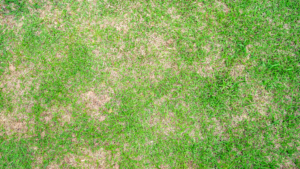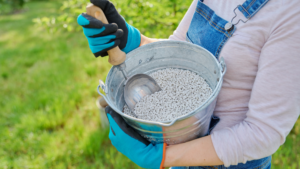A lush and healthy lawn enhances the beauty of your home and provides a perfect space for outdoor activities. As summer comes to an end, your lawn may show signs of stress from the intense heat and heavy use. Late-summer aeration can be the key to reviving your lawn and preparing it for the cooler months ahead.
Aeration involves creating small holes in the soil to allow air, water, and nutrients to penetrate deep into the grassroots. This simple process helps counteract the compacted soil and thatch buildup that often occur during the summer. Late-summer aeration sets the stage for a robust lawn by improving soil structure and root health.
In 2024, make it a priority to give your lawn the care it needs. Late-summer aeration helps reverse summer damage and strengthens your lawn for the changing seasons. Let’s explore why late-summer aeration is essential and how you can easily perform it to keep your yard looking its best.
Importance of Late-Summer Aeration

Late-summer aeration is vital for keeping your lawn healthy and vibrant. After months of intense heat and constant use, your lawn needs extra care to recover and thrive in the upcoming cooler months. Aerating your lawn at this time helps alleviate the problems caused by summer stress and prepares it for seasonal changes.
The heat and foot traffic during the summer months often compact the soil, making it difficult for air, water, and nutrients to reach the grassroots. This compaction can lead to weak, thin grass that is more susceptible to weeds, pests, and diseases. By aerating in late summer, you can break up the compacted soil, allowing essential elements to penetrate deeper into the ground, fostering stronger and healthier roots.
Additionally, late-summer aeration helps reduce thatch buildup, which is the layer of dead grass and roots that can suffocate your lawn. Aeration breaks through this thatch layer, improving water absorption and nutrient uptake. This results in a greener, more resilient lawn that can better withstand the challenges of the coming seasons.
Understanding Lawn Aeration
Lawn aeration involves creating small holes in the soil to allow vital elements like air, water, and nutrients to reach the grassroots. This process is essential for maintaining a healthy lawn, particularly in areas with compacted soil or heavy thatch buildup.
There are two main types of lawn aeration: core aeration and spike aeration.
1. Core Aeration: This method involves using a machine with hollow tines to remove small plugs of soil and thatch from the lawn. Core aeration is the most effective method as it relieves soil compaction and promotes better root growth.
2. Spike Aeration: This method uses solid tines or spikes to create holes in the soil. While easier to perform, it is less effective than core aeration because it can further compact the soil around the holes.
By understanding these methods and their benefits, you can choose the best one for your lawn’s specific needs. Proper aeration enhances the overall condition of your yard, leading to thicker, healthier grass.
Benefits of Aerating Your Lawn
Aerating your lawn offers numerous benefits that contribute to its overall health and appearance. Here are some of the key advantages of regular aeration:
1. Improved Soil Structure: Aeration loosens compacted soil, improving its structure and enabling roots to spread more easily.
2. Enhanced Water Uptake: With better soil structure, water can penetrate deeper into the soil, reducing runoff and ensuring your grass receives adequate moisture.
3. Increased Nutrient Absorption: Aeration allows essential nutrients to reach the grassroots, promoting stronger and healthier growth.
4. Reduced Thatch Buildup: Aeration breaks through the thatch layer, preventing it from suffocating your lawn and leading to healthier grass.
5. Stronger Root Systems: By alleviating soil compaction, aeration encourages roots to grow deeper and more robust, making your lawn more resilient to stress and drought.
6. Better Air Circulation: Creating holes in the soil improves air circulation, which is essential for root respiration and overall plant health.
7. Improved Lawn Density: Regular aeration promotes thicker, denser grass, which helps crowd out weeds and reduces the need for herbicides.
By regularly aerating your lawn, you can enjoy a healthier, more attractive yard that withstands the challenges of weather and foot traffic more effectively.
Signs Your Lawn Needs Aeration
Identifying the signs that your lawn needs aeration can help you maintain its health and beauty. Here are some indicators that it might be time to aerate your lawn:
1. Poor Water Drainage: If you notice water pooling on the surface of your lawn after rain or irrigation, it may be a sign of compacted soil that needs aeration.
2. Thinning Grass: Weak and thinning grass indicates that the roots are struggling to access the necessary air, water, and nutrients due to compacted soil.
3. Excessive Thatch: A thick layer of thatch that feels spongy underfoot can prevent water and nutrients from reaching the soil. Aeration helps break through this layer.
4. Heavy Foot Traffic: Areas with constant foot traffic, such as pathways or play areas, often suffer from soil compaction and benefit from aeration.
5. Soil Compaction Test: Perform a simple test by pushing a screwdriver or pencil into the soil. If it is difficult to insert, your soil is likely compacted and needs aeration.
6. Discolored Spots: Patches of yellow or brown grass may indicate that the roots are not receiving enough air, water, or nutrients due to compacted soil.
Recognizing these signs early can help you take action before your lawn’s health deteriorates further. Regular aeration keeps your lawn in optimal condition, ensuring it remains lush and green throughout the year.
How Aeration Reverses Summer Stress
Summer’s heat and frequent use can leave your lawn stressed and damaged. Aeration helps reverse this stress by improving several key aspects of your lawn’s health.
- Improved Root Growth: Aeration creates small holes in the soil, allowing air, water, and nutrients to reach the roots more effectively. Better access to these essentials helps roots grow deeper and stronger, making your lawn more resilient.
- Enhanced Water Absorption: Compacted soil can prevent water from penetrating deeply, leading to shallow root systems. Aeration breaks up compacted soil, allowing water to reach deeper, encouraging healthier root growth and reducing water runoff.
- Reduction of Thatch: Thatch is a layer of dead grass and roots that can build up on the soil’s surface, preventing water and nutrients from reaching the soil. Aeration helps break through this layer, allowing for better absorption and reducing the risk of disease.
By addressing these areas, aeration helps your lawn recover from summer stress, making it healthier and more vibrant.
Step-by-Step Guide to Aerating Your Lawn
Aerating your lawn can be straightforward if you follow these simple steps:
1. Mow Your Lawn: Before aerating, mow your lawn to about half its usual height. Shorter grass makes it easier for the aerator to work.
2. Water Your Lawn: Water your lawn a day before aerating. Moist soil is easier to aerate than dry soil.
3. Aerate the Lawn: Use a core aerator to create holes in the soil. Make several passes over the lawn in different directions to ensure even coverage.
4. Leave Soil Plugs: After aeration, leave the soil plugs on the lawn. They will break down and return nutrients to the soil.
5. Fertilize: Apply a balanced fertilizer after aeration to provide essential nutrients to the grass.
6. Water Again: Water your lawn thoroughly after fertilizing to help the nutrients penetrate deep into the soil.
Following these steps helps you aerate your lawn effectively, promoting better growth and overall health.
Choosing the Right Tools for Aeration

Using the right tools is crucial for successful lawn aeration. Here are some options to consider:
- Core Aerators: These machines remove small plugs of soil and are the most effective for reducing soil compaction. They are available for rent at most garden centers.
- Manual Aerators: Handheld or foot-operated tools work well for small lawns or targeted areas. These are less effective for large lawns due to the labor involved.
- Spike Aerators: These tools have solid tines that poke holes in the soil but can compact soil further around the holes. These are best for light aeration needs.
- Aerator Shoes: These are sandals with spikes that you can strap onto your shoes. They are less effective than other tools but are a fun way to aerate while walking around your yard.
Consider the size of your lawn and the severity of soil compaction when choosing a tool. Core aerators are generally the best option for most lawns.
Preparing Your Lawn for Aeration
Proper preparation is key to effective aeration. Here’s how to get your lawn ready:
1. Check Soil Moisture: Ensure your soil is moist, but not soggy. Watering the lawn a day before aeration helps achieve the right moisture level.
2. Clear the Lawn: Remove any debris such as sticks, leaves, or rocks that may obstruct the aerator.
3. Mark Obstacles: Identify and mark sprinkler heads, underground cables, or other obstacles to avoid damaging them during aeration.
4. Mow the Lawn: Mow your lawn to about half its usual height. Shorter grass makes it easier for the aerator to penetrate the soil.
5. Plan for Post-Aeration Care: Have a plan in place for fertilizing, overseeding, and watering after aeration to maximize benefits.
By following these steps, you can ensure your lawn is ready for aeration and set the stage for a healthier, more vibrant yard.
Post-Aeration Care and Maintenance
Once you’ve aerated your lawn, it’s essential to maintain it properly to maximize the benefits. Here are some key steps to take:
1. Watering: Water your lawn immediately after aeration to help the soil recover and to encourage root growth. Try to keep the soil moist but not waterlogged.
2. Fertilizing: Apply a balanced fertilizer to aid in healthy grass development. The nutrients will penetrate deeper into the soil through the aeration holes, promoting a healthier lawn.
3. Overseeding: Consider overseeding your lawn with grass seed. Aeration holes provide an ideal environment for new seeds to take root and grow, filling in bare spots and thickening your lawn.
4. Mowing: Hold off on mowing your lawn for a few days after aeration. This gives the soil time to settle and allows new grass to establish.
Following these steps can help your lawn recover quickly from summer stress and prepare it for healthy growth in the coming seasons.
Common Mistakes to Avoid During Aeration
Avoiding common mistakes during the aeration process can ensure your lawn gets the full benefits:
1. Aerating at the Wrong Time: Aerating too early or too late in the season can be ineffective. Late summer or early fall is the best time for aeration as it allows the lawn to recover and strengthen before winter.
2. Insufficient Watering: Not watering your lawn before and after aeration can limit the effectiveness of the process. Ensure your lawn is adequately moist but not saturated.
3. Uneven Aeration: Ensure even coverage when aerating your lawn. Missing spots can lead to uneven growth and a patchy appearance.
4. Neglecting Maintenance: Failing to follow up with proper post-aeration care, such as watering, fertilizing, and overseeding, can negate the benefits of aeration.
By avoiding these mistakes, you can achieve a greener, healthier lawn.
Frequently Asked Questions About Lawn Aeration
Here are some common questions and answers about lawn aeration:
1. How often should I aerate my lawn?
Most lawns benefit from aeration once a year. However, high-traffic areas or lawns with heavy clay soil may need aeration twice a year.
2. What are the signs that my lawn needs aeration?
Signs include compacted soil, water pooling, sparse grass growth, and thinning patches.
3. Can I aerate my lawn myself?
Yes, you can use a manual or mechanical aerator, but professional services ensure more thorough and effective results.
4. Is it better to aerate in the spring or fall?
Aeration is most effective in late summer or early fall, allowing your lawn to recover from summer stress and prepare for winter.
5. What type of aerator should I use?
Core or plug aerators are most effective as they remove plugs of soil, offering better soil decompaction.
Schedule Your Aeration Service With Plant It Earth
If your lawn is showing signs of stress or you just want it to look its best, scheduling an aeration service can make a significant difference. Aeration improves soil health, promotes grass growth, and revitalizes your lawn. At Plant It Earth, our experts provide top-notch aeration services tailored to your lawn’s specific needs.
Late Summer Lawn Rescue: The Power of Aeration
Achieving a healthy, lush lawn requires attention and care, especially after the stress of summer. Late-summer aeration is a crucial step in maintaining your lawn’s health and preparing it for seasonal changes. By understanding the importance of aeration, recognizing the signs of compacted soil, and following proper post-aeration care, you can ensure your lawn thrives.
Ready to give your lawn the care it deserves? Contact Plant It Earth today to schedule your professional aeration service in West-Central Florida and see the difference it can make. Your lawn will thank you!
